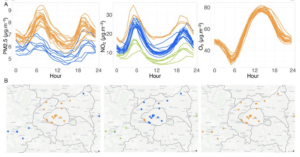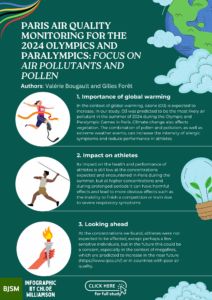Authors: Valérie Bougault and Gilles Forêt
This study is the result of a collaboration between French air quality and pollen measurement organisations (Airparif and RNSA) and French researchers in sports science (Université Côte d’Azur) and climate and environmental sciences (Université Paris Est Créteil, Université Paris Cité, Université de Lille and Laboratoire des Sciences du Climat et de l’Environnement) to provide a priori information to participants in the Paris Olympic and Paralympic Games.
Why is this study important?
Air quality affects the health of individuals depending on the type of pollutant and its concentration, and may have an impact on performance of some athletes. Predicting the air quality before the Olympic and Paralympic Games, i.e. the type of pollutants and pollen, their concentrations and their variation factors in the Olympic venues, can enable clinicians to anticipate and, if necessary, adapt the management of their patients/athletes going to the Games and give them appropriate advice.
How did the study go about this?
The description of the spatial and temporal variation of air pollution in Paris region (France) was based on data from the 50 permanent automatic monitoring stations of the Airparif network. These stations provide continuous measurements on an hourly basis, allowing real-time monitoring of pollutants (particulate matters PM; Nitrogen dioxide NO2 and Ozone O3). There are three main types of station: urban/suburban background stations, rural background stations and traffic stations located near traffic lanes. The concentrations of the main pollutants during the 3-month summer season (July to September) were calculated for a 4-year period (2020-2023). A model-based assessment of air pollution at the Olympic sites was carried out using Airparif modelling systems and clustering was performed on the simulated concentrations at the Olympic sites to identify categories of sites with similar pollution levels. The aerobiological monitoring sites were part of the French Aerobiological Surveillance Network (RNSA, France) and the Aerosol, Clouds and Trace Gases Research Infrastructure (ACTRIS, Europe). Daily pollen concentrations were collected using a volumetric impaction sampler (VIS) via a Hirst-type spore trap and results were available as 2-hour averages. For each pollutant, the number of days exceeding the recommended limits was reported. The potential health and performance effects of exposure to the pollutants were then suggested in the context of the literature investigating the effects of pollutants at these concentrations in athletes and susceptible individuals.
What did the study find?
We have defined several clusters of pollutant concentrations during the summer (see figure). Air quality in Paris during the summer can be characterised mainly by high O3 levels in the afternoon, especially on sunny and hot days. Local increases in PM2.5 and NO2 can occur near busy roads and in urban areas. The maximum hourly concentrations observed during the four summers (2020-2023) were 221 µg/m3 for O3, 60 µg/m3 for PM2.5 (urban) and 200 ug/m3 for NO2 (traffic). In the summer in Paris, pollen levels are much lower than in spring, but the grass pollen can still be problematic for allergy sufferers.

What are the key take-home points?
In the context of global warming, ozone (O3) is expected to gradually increase. In our study, O3 was predicted to be the most likely air pollutant in the summer of 2024 during the Olympic and Paralympic Games in Paris during few days, as in any country/region where the weather is clear, warm and sunny. Its impact on the health and performance of athletes is still low at the concentrations expected and encountered in Paris during the summer, but at higher concentrations and during prolonged periods it can have harmful effects and lead to more obvious effects such as the inability to finish a competition or train due to severe respiratory symptoms. The importance of NO2 and PM2.5 was limited to traffic areas and urban centres in our projections for the summer of 2024 in Paris. At the concentrations we found, athletes were not expected to be affected, except perhaps a few sensitive individuals, but in the future this could be a concern, especially in the context of megafires, which are predicted to increase in the near future (https://www.ipcc.ch/).
